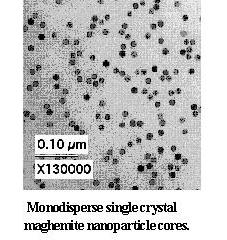[Research
Home] [Nanobiomagnetism
Home]
Magnetic Nanoparticles
for Brain Tumor Treatment
Funding: Campbell Endowment at UW, National
Physical Science Association
Project Summary:
Hyperthermia, or the controlled heating of tissue
to promote cell necrosis, with magnetic nanoparticles
has the potential to be a powerful cancer treatment.
Magnetic nanoparticles coated in a lipid bilayer,
magnetoliposomes, can combine heat therapy with
drug delivery to provide a synergistic treatment
strategy. Magnetic particles can be injected into
a patient and guided to a target site with an external
magnetic field and/or specifically bind to target
cells via recognition molecules coated onto the
surface of the particles. We have developed a collaboration
with the Mourad group in the Department of Neurological
Surgery to combine their expertise in opening up
the blood-brain-barrier, using focused ultrasound
with our ?-Fe2O3 magnetic nanoparticles for the
treatment of brain tumors.
For optimum performance, control
over the synthesis of the nanoparticles and their
surface modification is critical. We have prepared
highly uniform, monodisperse, single-crystal maghemite
nanoparticles of tailorable size (5 - 20 nm) via
an organometallic decomposition method. A surfactant
coats the particles during synthesis and plays a
key role in the nucleation and growth of the particles
as well as the resulting particle geometry. As-synthesized
particles are initially hydrophobic. However, coating
the particles with a second lipid layer is an effective
route to make them hydrophilic. Using well-established
principles of lipid self-assembly we have successfully
coated a second layer of lipid, 1,2-Dipalmitoyl-sn-Glycero-3-Phosphocholine
(DPPC) on the as-synthesized particles.

Heat generation by superparamagnetic
particles is highly dependent on particle size,
crystallinity and shape. Heating rates deteriorate
quickly with polydispersity of particles. The physics
of magnetic heating suitable for biological applications
requires considerable investigation, involving the
choice of the optimum particle size and magnetic
anisotropy and studies of complex magnetic susceptibility,
specific heat and power dissipation.
Recent publications:
M. Gonzales and Kannan M. Krishnan,
"Synthesis of Magnetoliposomes with Monodisperse
Iron Oxide Nanocrystal Cores for Hyperthermia",
JMMM (in press)
Recent oral presentations:
M. Gonzales, International conference
on Scientific and Clinical Applications of Magnetic
Carriers, Lyon, France, "Synthesis of Magnetoliposomes
with Monodisperse Iron Oxide Nanocrystal Cores for
Hyperthermia", May 2004
[Research
Home] [Nanobiomagnetism
Home]